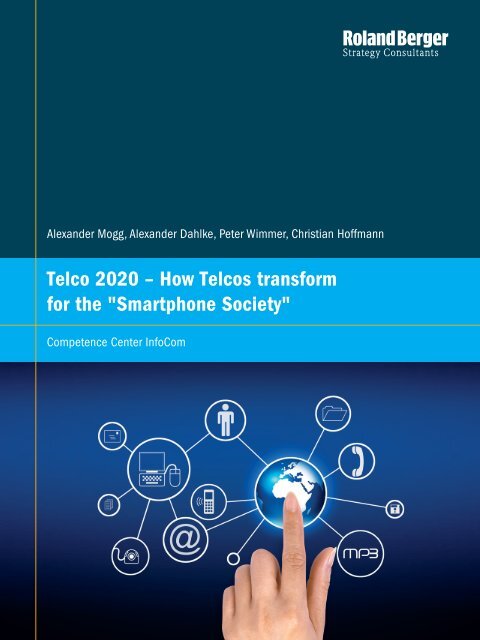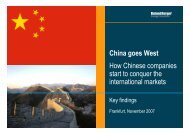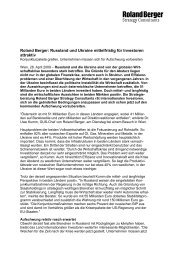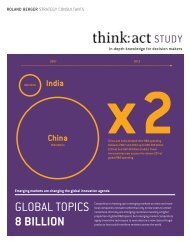Telco 2020 â How Telcos transform for the ... - Roland Berger
Telco 2020 â How Telcos transform for the ... - Roland Berger
Telco 2020 â How Telcos transform for the ... - Roland Berger
Create successful ePaper yourself
Turn your PDF publications into a flip-book with our unique Google optimized e-Paper software.
Competence Center InfoCom 1<br />
Alexander Mogg, Alexander Dahlke, Peter Wimmer, Christian Hoffmann<br />
<strong>Telco</strong> <strong>2020</strong> – <strong>How</strong> <strong>Telco</strong>s <strong>trans<strong>for</strong>m</strong><br />
<strong>for</strong> <strong>the</strong> "Smartphone Society"<br />
Competence Center InfoCom
2<br />
<strong>Telco</strong> <strong>2020</strong> – <strong>How</strong> <strong>Telco</strong>s <strong>trans<strong>for</strong>m</strong> <strong>for</strong> <strong>the</strong> "Smartphone Society"<br />
Management summary<br />
A battle of giants is brewing in <strong>the</strong> world of telecommunications. Traditional telcos, with<br />
<strong>the</strong>ir five billion customers worldwide, are getting ready to take on new Internet-focused<br />
rivals offering communication plat<strong>for</strong>ms, services and content via smartphones, tablets and<br />
Internet-enabled TVs. Right now, <strong>the</strong> strongest of <strong>the</strong>se are <strong>the</strong> "fab(ulous) five": Amazon,<br />
Apple, Facebook, Google and Microsoft, who serve over three billion customers between<br />
<strong>the</strong>m. Traditional telcos and <strong>the</strong>ir modern rivals each have a total market capitalization of<br />
round about EUR 800 billion. Current public opinion favors <strong>the</strong> fab five with <strong>the</strong>ir superior<br />
innovative capabilities, breathtaking growth rates and large cash reserves. But will that be<br />
enough to threaten <strong>the</strong> traditional telcos?<br />
The fab five certainly enjoy a number of advantages, including daily "branded contact" with<br />
customers, close customer bonds with <strong>the</strong>ir easy-to-use, personalized service ecosystems<br />
and, increasingly, a willingness on <strong>the</strong> part of customers to pay <strong>for</strong> such services. Pureplay<br />
broadband access – <strong>the</strong> mainstay of traditional telcos' business today – will remain<br />
<strong>the</strong> cornerstone of digital communication in <strong>the</strong> future <strong>for</strong> both landlines and mobile<br />
communication. While usage and associated data volumes continue to grow exponentially ,<br />
however, telcos are under <strong>the</strong> price pressure that inevitably accompanies commoditization<br />
while <strong>the</strong> industry so far has failed to monetize volume growth.<br />
So what can telcos do in <strong>the</strong>ir battle with <strong>the</strong> giants? This is <strong>the</strong> question answered by our<br />
global study "<strong>Telco</strong> <strong>2020</strong> – <strong>How</strong> telcos <strong>trans<strong>for</strong>m</strong> <strong>for</strong> <strong>the</strong> Smartphone Society". Our talks with<br />
more than 25 top decision-makers representing <strong>the</strong> entire spectrum of telecommunications<br />
revealed that <strong>the</strong> "right" strategic orientation <strong>for</strong> each telco will depend on five key levers:<br />
1) Personalization of service ecosystem and <strong>the</strong> customer experience;<br />
2) staunch defense of relationships with end customers;<br />
3) cost-efficient broadband network build-up;<br />
4) <strong>the</strong> realignment and radical streamlining of operating models;<br />
5) <strong>the</strong> financial resources to drive digital <strong>trans<strong>for</strong>m</strong>ation and consolidation.<br />
Three realistic scenarios emerge from this finding. In extreme cases, telcos will do no more<br />
than engage in what can be termed "Access Minus" business, primarily providing network<br />
infrastructure as wholesale service providers that have all but been cut off from <strong>the</strong>ir<br />
relationship with <strong>the</strong> end customers. Companies with better strategic positions and deeper<br />
pockets will develop <strong>the</strong>ir own access-centric services and selective over-<strong>the</strong>-top (OTT)<br />
offerings, positioning <strong>the</strong>mselves as "Access Plus" providers. Only a handful of regional telco<br />
groups will, through acquisitions, establish <strong>the</strong>mselves as "OTT service groups" capable of<br />
competing with <strong>the</strong> fab five in <strong>the</strong> complex "OTT Game".
Competence Center InfoCom 3<br />
None of <strong>the</strong>se three strategies is inherently right or wrong. Provided <strong>the</strong>y make a convincing<br />
job of executing <strong>the</strong> strategy, even companies that back <strong>the</strong> Access Minus horse can develop<br />
successfully and stimulate hopes of value growth on <strong>the</strong> stock market.<br />
We believe that virtually all telcos can manage this approach, even if some incumbent<br />
players currently appear overvalued. Ultimately, though, five golden rules will separate<br />
<strong>the</strong> winners from <strong>the</strong> losers:<br />
1) Get <strong>the</strong> core access business right – Converged broadband access,<br />
personalized service suites, experience-based;<br />
2) Make targeted, realistic "bets" with regard to growth and differentiation<br />
(in <strong>the</strong> case of Access Plus strategies and <strong>for</strong>ward-looking OTT investments);<br />
3) Trans<strong>for</strong>m into lean telcos with de-layered operating models and<br />
only half of today's work<strong>for</strong>ce;<br />
4) Convince capital markets by presenting <strong>the</strong>m with attractive consolidation<br />
and streamlining stories, abandoning secondary activities and committing<br />
to cooperative ventures; and finally…<br />
5) Act quickly and resolutely.<br />
Only <strong>the</strong>n can <strong>the</strong> industry resume its pattern of value growth and begin offering shareholders<br />
attractive returns again – despite <strong>the</strong> erosion of its core business and <strong>the</strong> best ef<strong>for</strong>ts of<br />
global rivals such as Apple and Google.<br />
Welcome to <strong>the</strong> "Smartphone Society" – a glimpse of <strong>the</strong> future<br />
Snapping your fingers is all it takes to silence <strong>the</strong> smartphone alarm, getting digital assistant<br />
Siri to answer your mails be<strong>for</strong>e you even get out of bed, commenting on <strong>the</strong> first Facebook<br />
postings of <strong>the</strong> day while brushing your teeth and switching on <strong>the</strong> espresso machine. A<br />
doppio, if you don't mind. Since your girlfriend is still away on business, you will have to<br />
make do with <strong>the</strong> hologram projected onto <strong>the</strong> table by your mobile <strong>for</strong> small talk over coffee.<br />
Five minutes later, your phone opens <strong>the</strong> car door. As you climb in, you tell <strong>the</strong> voice control<br />
<strong>the</strong> name of <strong>the</strong> business partner in Korea who you want to talk to on <strong>the</strong> way to work – both<br />
of you speaking your own language, interpreted simultaneously and appearing on <strong>the</strong> headup<br />
video display.<br />
In short, <strong>the</strong> digital <strong>trans<strong>for</strong>m</strong>ation is turning our day-to-day lives upside down.
4<br />
<strong>Telco</strong> <strong>2020</strong> – <strong>How</strong> <strong>Telco</strong>s <strong>trans<strong>for</strong>m</strong> <strong>for</strong> <strong>the</strong> "Smartphone Society"<br />
Ubiquitous communication: Ever since <strong>the</strong> smartphone, tablet and Internet-enabled TV<br />
began <strong>the</strong>ir triumphal march, we have been online almost permanently, often with multiple<br />
devices simultaneously. Worldwide usage data shows that, apart from over dinner and<br />
when we are asleep, <strong>the</strong>re is no time when we do not engage in online communication.<br />
And that is only <strong>the</strong> beginning. We are well on our way to becoming a smartphone society,<br />
a telecommunicative world that, while perhaps still a distant dream <strong>for</strong> many consumers<br />
and providers, appears inevitable to us at <strong>Roland</strong> <strong>Berger</strong>.<br />
Customers don't buy access, <strong>the</strong>y buy service ecosystems: In <strong>the</strong> future, our communication<br />
will revolve around social media plat<strong>for</strong>ms, dominated by Internet firms such as<br />
Apple, Facebook and o<strong>the</strong>rs that do not even exist yet. The Google+ videotelephony project<br />
launched in 2011 shows <strong>the</strong> way <strong>for</strong>ward <strong>for</strong> integrated communication environments that,<br />
building on a personal or organizational network, set up telephony, messaging, mail, chat<br />
or video links at <strong>the</strong> click of a button.<br />
This will naturally affect telcos' revenue streams. Voice over IP (VoIP) telephony is doing<br />
away with <strong>the</strong> need <strong>for</strong> traditional, landline phones. Free chat apps are replacing profitable<br />
services such as text messaging. Even online videotelephony is emerging as a free service,<br />
(although it tends to clog up networks). Future data tariffs will only compensate <strong>for</strong> part of<br />
<strong>the</strong>se losses, even after more bandwidth and greater data usage has been priced in. Worse<br />
still, young, tech-savvy customers are getting used to interacting from within <strong>the</strong> service<br />
ecosystems set up by over-<strong>the</strong>-top (OTT) players and are just a click away from <strong>the</strong> latter's<br />
all-in service offerings. These ecosystems are where <strong>the</strong>y come to meet friends, buy music,<br />
post news and pay <strong>for</strong> online purchases. So why should <strong>the</strong>y leave <strong>the</strong>ir familiar "home"<br />
environment just to communicate?
Competence Center InfoCom 5<br />
Usability and service experience – <strong>the</strong> keys to customer acceptance: Separate individual<br />
contracts are increasingly giving way to demand <strong>for</strong> access packages that bundle broadband<br />
connectivity <strong>for</strong> mobile phones and <strong>the</strong> Internet. As things stand, just 10% of customers buy<br />
contracts that combine mobile and landline communication. Yet this figure is expected to rise<br />
to 60% by <strong>2020</strong>. In <strong>the</strong> end, customers pick <strong>the</strong> provider whose digital service suite matches<br />
<strong>the</strong>ir patterns of usage as closely as possible, and that also supplies attractive handsets. Future<br />
offerings will have to function independently from devices and network access, especially at a<br />
time when mobile Internet is becoming increasingly important worldwide. Communication is no<br />
longer a separate service. It has become an integral part of social networks and o<strong>the</strong>r e-service<br />
ecosystems that embrace entertainment, shopping and healthcare, <strong>for</strong> example.<br />
<strong>Telco</strong>s need to compete with <strong>the</strong> fab five: Amazon, Apple, Facebook, Google and Microsoft are<br />
spreading <strong>the</strong>ir tentacles and occupying more and more of <strong>the</strong> service territory. They are offering<br />
Internet applications, <strong>the</strong>ir own devices and plat<strong>for</strong>ms on which customers can (although <strong>the</strong>y<br />
rarely do in practice) combine all <strong>the</strong>ir online activities – even if <strong>the</strong> service ecosystem builds<br />
barriers to o<strong>the</strong>r ecosystems. In <strong>the</strong> future, customers will be willing to pay <strong>for</strong> simple, fast<br />
access to <strong>the</strong>se ecosystems. Pure-play broadband access will remain <strong>the</strong> cornerstone that even<br />
<strong>the</strong> fab five will have to use. But given <strong>the</strong> <strong>for</strong>ecast ubiquity of optical fiber networks and highspeed<br />
wireless connections, it is increasingly being regarded as an interchangeable commodity.<br />
As a result, price pressure is growing.
6<br />
<strong>Telco</strong> <strong>2020</strong> – <strong>How</strong> <strong>Telco</strong>s <strong>trans<strong>for</strong>m</strong> <strong>for</strong> <strong>the</strong> "Smartphone Society"<br />
Personalization: Ease of use based on intuitive access to a familiar ecosystem, one-stop<br />
shopping and customer services will become core requirements, precisely because <strong>the</strong> market<br />
is flooded with so many disparate devices and offerings. The fab five already attach great<br />
importance to personalized recommendation marketing ("I like", "Amazon Recommendations"<br />
and "Google Search", <strong>for</strong> example). Future telco offerings will have to be personalized to <strong>the</strong><br />
same degree, including apps to answer everyday questions, from "What's on TV?" to "Is <strong>the</strong><br />
freeway clear?", not to mention <strong>the</strong> availability in <strong>the</strong> cloud of personalized content that is<br />
independent of specific devices.<br />
<strong>Telco</strong>s have some fundamental rethinking to do –<br />
our motivation <strong>for</strong> this study<br />
<strong>Telco</strong>s need to understand each and every one of <strong>the</strong>ir five billion customers, <strong>the</strong>ir networks<br />
and <strong>the</strong>ir preferences, ra<strong>the</strong>r than trying to supply <strong>the</strong> masses with one-size-fits-all infrastructure<br />
products. The good news is that no-one has as much in<strong>for</strong>mation as <strong>the</strong> telcos do. The bad news<br />
is that no-one does as little with it. They scarcely seem able to use this knowledge to personalize<br />
sales and services.<br />
Not so <strong>the</strong> five Internet players. Amazon (300 million shoppers), Apple (over 250 million iOS<br />
installed), Facebook (845+ million users), Google (over one billion search engine users, 200+<br />
million "Androids") and Microsoft (over 660 million Skype users) dominate <strong>the</strong> OTT game.<br />
They have our data and <strong>the</strong>y are not afraid to use it. Consistent personalization makes <strong>the</strong>m<br />
indispensable. They are our daily companions because nearly all of us use <strong>the</strong>ir services. They<br />
also beat telcos on finance and innovation – a fact that stock markets have rewarded with<br />
considerable increases in <strong>the</strong>ir share prices in some cases.<br />
Tellingly, not a single European firm appears on <strong>the</strong> list of most valuable internet business<br />
brands. Nor do many people expect to see <strong>the</strong>m <strong>the</strong>re any time soon, as <strong>the</strong> digital <strong>trans<strong>for</strong>m</strong>ation<br />
undermines <strong>the</strong> position of traditional telcos. Revenues and profits are in decline even as<br />
companies have to invest more just to compete. If <strong>the</strong> telcos continue to rely on <strong>the</strong>ir existing<br />
strategies and business models, revenues will drop by as much as 20% and EBITDA by as much<br />
as 40%. The lost profit will find its way to <strong>the</strong> fab five, o<strong>the</strong>r OTT providers and cable companies.<br />
At <strong>the</strong> same time, European telcos will need to invest a total of more than EUR 600 billion by<br />
<strong>2020</strong>. Most of this will be required by today's core business, on optical fiber networks and LTE,<br />
driven by political requirements and competition from cable operators with <strong>the</strong>ir 100+ megabit<br />
connections.<br />
In <strong>the</strong> short term, this will lead to a considerable increase in investment levels <strong>for</strong> some<br />
players. O<strong>the</strong>rs will attempt to spread <strong>the</strong>ir investments over a longer period, but in so doing<br />
lose valuable time in <strong>the</strong> competition <strong>for</strong> shares in <strong>the</strong> broadband market. In a shrinking market,<br />
telcos can only cope with <strong>the</strong>se losses if <strong>the</strong>y consolidate intelligently.
Competence Center InfoCom 7<br />
They must slim down <strong>the</strong>ir various network, sales and service business models, abandon<br />
secondary activities and use M&As or cooperative ventures to penetrate fast-growing markets.<br />
All of this leaves little money and less time to "bet" on new strategies and business models.<br />
Worse still, <strong>the</strong> experts we spoke to do not believe that <strong>the</strong> traditional telcos have <strong>the</strong> innovative<br />
capability required to engage in a competitive battle with <strong>the</strong> fab five.<br />
Prompted by <strong>the</strong> upheaval in <strong>the</strong> market and competitive landscape, <strong>Roland</strong> <strong>Berger</strong> took a<br />
closer look at <strong>the</strong> future role firms will play, expectations with regard to <strong>the</strong>ir business models<br />
and <strong>the</strong> necessary consolidation. To prepare our study "<strong>Telco</strong> <strong>2020</strong> – <strong>How</strong> telcos <strong>trans<strong>for</strong>m</strong><br />
<strong>for</strong> <strong>the</strong> Smartphone Society", we interviewed more than 25 decision-makers representing <strong>the</strong><br />
entire telecoms value chain all over <strong>the</strong> world, including six of <strong>the</strong> ten global leading telcos,<br />
equipment providers, Internet market leaders and investors. The participating companies post<br />
combined annual revenues of around EUR 400 billion – about a third of <strong>the</strong> global industry total.<br />
Half of our interviewees were board members or CEOs who take <strong>the</strong>se changes into account<br />
in <strong>the</strong>ir decisions day in, day out.<br />
What industry CxOs think – <strong>the</strong> results<br />
The interviews were revealing. Top managers are clearly in broad agreement about <strong>the</strong><br />
course <strong>the</strong> market will take. But <strong>the</strong>y are very uncertain about <strong>the</strong>ir own relationship with<br />
end customers, <strong>the</strong>ir ability to cope with <strong>the</strong> digital <strong>trans<strong>for</strong>m</strong>ation and about consolidation<br />
scenarios. The resultant strategic and timing considerations are equally unclear. At <strong>the</strong> same<br />
time, our interviews highlighted <strong>the</strong> different opportunities opening up <strong>for</strong> telcos. Depending<br />
on how <strong>the</strong>y position <strong>the</strong>mselves, incumbents can indeed stand up to new competitors and<br />
succeed in a game whose rules are changing beyond recognition.
8<br />
<strong>Telco</strong> <strong>2020</strong> – <strong>How</strong> <strong>Telco</strong>s <strong>trans<strong>for</strong>m</strong> <strong>for</strong> <strong>the</strong> "Smartphone Society"<br />
Current market figures and expectations <strong>for</strong> Europe suggest that two issues are key with<br />
regard to telcos' future strategic orientation:<br />
1. Access will remain <strong>the</strong> backbone of most telcos' business.<br />
2. To be equipped <strong>for</strong> growth markets, many telcos will also offer Access Plus services,<br />
covering everything from <strong>the</strong> marketing of access-centric plat<strong>for</strong>ms to mostly<br />
regional OTT services.<br />
Access will remain <strong>the</strong> major source of revenue and hence <strong>the</strong> core of every telco strategy in<br />
<strong>the</strong> long run. In 2015, we expect to see revenue totaling some EUR 300 billion in Europe.<br />
Around two-thirds of this amount will be attributable to mobile communication, partly because<br />
LTE networks will have substituted as much as 10-20% of landline Internet connections.<br />
Due to <strong>the</strong>ir experience with infrastructure, <strong>the</strong>ir heavy investment in more efficient<br />
broadband access networks and <strong>the</strong> savings permitted by leaner business models, telcos can<br />
continue to generate EBITDA margins of as much as 35% to 45% by delivering access alone.<br />
Having said that, this core business area will stagnate until 2015. Given <strong>the</strong> upheaval on <strong>the</strong><br />
communications market, we expect to see a decline of 1% to 2% a year until <strong>2020</strong>. Activities<br />
such as hosting, data storage and security services – all of which build on access – are <strong>the</strong><br />
exception to <strong>the</strong> rule. These cloud technologies are enjoying double-digit growth. They are<br />
attractive to telcos because <strong>the</strong>y upgrade "mere" access, allow to capitalize on <strong>the</strong>ir networks,<br />
help to retain customers, <strong>the</strong>ir data and <strong>the</strong>ir applications, and so allow companies<br />
to gain a foothold in <strong>the</strong> OTT segment.
Competence Center InfoCom 9<br />
In adjacent business lines that rely on <strong>the</strong> telcos' network and IT service plat<strong>for</strong>ms, it makes<br />
sense to cooperate and place selective bets in order to grow and cultivate a distinctive value<br />
proposition. To what extent telcos succeed, however, will naturally depend on <strong>the</strong>ir own capabilities,<br />
<strong>the</strong>ir potential to become market leaders and whe<strong>the</strong>r <strong>the</strong> markets <strong>the</strong>y serve follow<br />
local or global rules.<br />
Regional telco groups such as Telefónica, Vodafone and Deutsche Telekom and national<br />
champions such as Telecom Italia, KPN and Swisscom are setting <strong>the</strong>ir sights on similar<br />
areas of growth: payment services, advertising, energy services, smart home services and<br />
healthcare services ("e-health"), to name but a few. To take <strong>the</strong> latter segment as an example,<br />
many patients may not yet be able to imagine having, say, <strong>the</strong>ir blood pressure<br />
measured by a mobile service provider. Yet Telecom Italia is using precisely this kind of<br />
remote monitoring system to save older patients <strong>the</strong> hassle of spending time in hospital<br />
and to save <strong>the</strong> national health system money. E-health may not be a large market. But<br />
given that healthcare is heavily dependent on national legislation, it seems a sensible niche<br />
to occupy as global OTT players are unlikely to be interested in developing suitable offerings<br />
<strong>for</strong> each and every country. European telco groups might even have <strong>the</strong> chance to establish<br />
a European standard – although <strong>the</strong>re is as yet no sign that telcos plan to prioritize such<br />
opportunities in collaboration with healthcare partners.<br />
On <strong>the</strong> o<strong>the</strong>r hand, payment services and advertising business <strong>for</strong>ce national incumbents<br />
to line up against international competitors. Payment by mobile phone is regarded as a<br />
market that has so far been neglected but could be worth billions. Things are slowly beginning<br />
to move. Japan's NTT, <strong>for</strong> example, is already in possession of bank licenses in Europe.<br />
Deutsche Telekom, Vodafone and O2 have come toge<strong>the</strong>r to <strong>for</strong>m <strong>the</strong> "mpass" joint venture<br />
– a payment system <strong>for</strong> online purchases by mobile phone. OTT players are also joining<br />
<strong>the</strong> fray, as evidenced by <strong>the</strong> Google Wallet, Facebook's "Credits" and <strong>the</strong> eBay subsidiary<br />
PayPal.<br />
<strong>Telco</strong>s that go beyond access-centric services and plat<strong>for</strong>ms will encroach on <strong>the</strong> OTT turf<br />
that <strong>the</strong> fab five have made <strong>the</strong>ir own. In <strong>the</strong> short term, TV promises to deliver <strong>the</strong> most<br />
revenue and will be a necessary weapon in local competition. In <strong>the</strong> long term, however,<br />
traditional telcos will scarcely be able to hold this ground as <strong>the</strong>y simply cannot keep pace<br />
with global OTTs such as Facebook and Google+ or portals such as iTunes, YouTube, Netflix<br />
and Hulu – particularly as local content providers can easily make use of <strong>the</strong>ir own plat<strong>for</strong>ms.<br />
<strong>Telco</strong>s face <strong>the</strong> same dilemma on <strong>the</strong> subject of music libraries, online games, app stores<br />
and e‐commerce stores. They may stand a better chance in sectors with a more local focus,<br />
such as special regional areas of e‐commerce. Alternatively, <strong>the</strong>y might follow <strong>the</strong> example<br />
of Japan's telecommunications company Softbank and invest in a portfolio of potential<br />
future OTT market leaders – ano<strong>the</strong>r way of betting on <strong>the</strong> future.
10<br />
<strong>Telco</strong> <strong>2020</strong> – <strong>How</strong> <strong>Telco</strong>s <strong>trans<strong>for</strong>m</strong> <strong>for</strong> <strong>the</strong> "Smartphone Society"<br />
Theoretically, <strong>the</strong>n, <strong>the</strong> options range from pure-play access business – with telcos operating<br />
more or less as anonymous wholesale providers in extreme cases – to engaging in handto-hand<br />
combat in <strong>the</strong> OTT boxing ring. According to <strong>the</strong> results of our interviews, <strong>the</strong> best<br />
strategy <strong>for</strong> a particular operator depends on five key levers: <strong>the</strong> personalization of service<br />
suites and <strong>the</strong> customer experience; staunch defense of relationships with end customers;<br />
cost-efficient broadband network build-up; <strong>the</strong> realignment and streamlining of business<br />
models; and <strong>the</strong> financial resources to drive digital <strong>trans<strong>for</strong>m</strong>ation and consolidation.<br />
Personalization of service suites and <strong>the</strong> customer experience<br />
The more complex our service environment becomes, <strong>the</strong> more important consumers will place<br />
on personally tailored, functioning offerings that meet all <strong>the</strong>ir needs. For providers, this means<br />
giving every user a plat<strong>for</strong>m on which <strong>the</strong>y can bundle <strong>the</strong>ir apps, in<strong>for</strong>mation, entertainment,<br />
shopping and communication services, and where <strong>the</strong>y can also find someone to help <strong>the</strong>m<br />
with any questions or problems that crop up. This service suite must be structured in such a<br />
way that it can be custom-tailored, irrespective of what devices and networks users choose or<br />
where <strong>the</strong>y happen to be. In <strong>the</strong> future, customers will expect to be able to take an ongoing<br />
call seamlessly from <strong>the</strong>ir office phone to <strong>the</strong>ir mobile and have it put through to <strong>the</strong> handsfree<br />
device in <strong>the</strong>ir car automatically as soon as <strong>the</strong>y turn on <strong>the</strong> ignition. To put that ano<strong>the</strong>r<br />
way, service suites must work in <strong>the</strong> background; <strong>the</strong>y will not always be visible.<br />
But what should a successful personalized suite look like? Let's take entertainment as an<br />
example: Premium and basic packages <strong>for</strong> different target groups – young people, families,<br />
over-50s – simplify <strong>the</strong> task of communicating and picking <strong>the</strong> right services. Each package<br />
will include standard content such as an app store, access to 3D Internet TV and preinstalled<br />
links to important networks and programs. Telephony and broadband Internet access will<br />
likewise be preinstalled. Switch on, go shopping, communicate immediately: that will be<br />
<strong>the</strong> value proposition.<br />
Personalized but free add-on services such as video<strong>the</strong>ques (along <strong>the</strong> lines of BBC's iPlayer),<br />
secure single sign-on facilities across mobiles, tablets and <strong>the</strong> TV, and a firewall or cloudbased<br />
storage will complement <strong>the</strong> standard-issue functions. Customers will select <strong>the</strong>se<br />
functions ei<strong>the</strong>r in a service configurator or, on <strong>the</strong> basis of past usage patterns, <strong>the</strong> provider's<br />
"recommendation engine" will suggest <strong>the</strong>m itself (e.g. "customers who chose …, often<br />
choose …").<br />
Exclusive add-on functions will allow users to fur<strong>the</strong>r personalize <strong>the</strong> service suite, creating<br />
a genuine "wow factor" that boosts customer retention and enriches <strong>the</strong> brand experience.<br />
Variations on <strong>the</strong> <strong>the</strong>me of <strong>the</strong> Apple Store's Genius Bar, where specially trained staff provide<br />
live help <strong>for</strong> customer problems, would be conceivable in a service cosmos that combines<br />
offline and online support. Premium services such as links to American Express-style concierge<br />
services <strong>for</strong> local cultural offerings, and maybe a personal rendition of "Happy birthday to<br />
you!" by Lady Gaga – or at least her hologram – in <strong>the</strong> customer's living room, will set <strong>the</strong><br />
bar <strong>for</strong> providers of OTT environments, services and consumer goods.
Competence Center InfoCom 11<br />
Staunch defense of relationships with end customers<br />
The battle <strong>for</strong> customers will be won not with services alone, but with every aspect of <strong>the</strong><br />
ecosystem. Communication devices, too, will have a crucial role to play – partly because<br />
<strong>the</strong>y often clinch a decision whe<strong>the</strong>r or not to sign a telco contract.<br />
Unlike <strong>the</strong> situation today, telcos will no longer determine which handset manufacturers<br />
succeed merely by displaying <strong>the</strong>ir devices in <strong>the</strong>ir showrooms. Instead, global brands will<br />
sell <strong>the</strong>ir own smartphones, tablets and Internet TV devices directly or via retail partners.<br />
Apple has been showing how this can work ever since it launched <strong>the</strong> iPhone in 2007.<br />
Google is streng<strong>the</strong>ning its position with rapid dissemination of <strong>the</strong> Android operating system<br />
and <strong>the</strong> acquisition of Motorola's mobile communications arm. Toge<strong>the</strong>r with HTC, Facebook<br />
plans to launch its own mobile phone – called Buffy – starting in spring 2012. Following its<br />
Kindle Fire, Amazon is also said to be working on a smartphone. Microsoft has teamed up<br />
with Nokia to develop <strong>the</strong> Lumia family if devices in an attempt to relaunch its own<br />
operating system.<br />
For now, however, it is unlikely that <strong>the</strong>se moves by OTTs will trigger a power struggle in<br />
<strong>the</strong> device segment. The telcos still have a dominant 45% share of distribution channels<br />
in Europe. The billions that telcos pay in sales premiums give <strong>the</strong>m huge clout in retail and<br />
reseller channels. Not only that, <strong>the</strong>y massively subsidize consumers' handset purchases –<br />
to <strong>the</strong> tune of more than EUR 20 billion a year in Europe alone. That's <strong>the</strong> kind of cash <strong>the</strong><br />
fab five would first have to splash to keep pace with telcos' <strong>for</strong>thcoming assault on <strong>the</strong> market.<br />
To reach <strong>the</strong> mass consumer market, over-<strong>the</strong>-counter prices have to be below EUR 100.<br />
And up to now, Amazon alone has dared to venture into this territory, with <strong>the</strong> Kindle. So<br />
<strong>the</strong>re are a number of reasons to believe that, <strong>for</strong> <strong>the</strong> time being, telcos, OTTs and device<br />
manufacturers will continue to coexist more or less peacefully. "We quite simply depend on<br />
each o<strong>the</strong>r to an incredible extent," underlined Google CEO Eric Schmidt, as recently as <strong>the</strong><br />
2011 G8 Summit.<br />
It is never<strong>the</strong>less a fact that OTTs and device manufacturers possess powerful weapons –<br />
<strong>the</strong>ir SIM technology, operating systems and seamless integration in app stores – with which<br />
to herald a "changing of <strong>the</strong> guard". Technologically, it is already possible to use apps or <strong>the</strong><br />
operating system to install a "soft SIM" on <strong>the</strong> handset that allows users to choose <strong>the</strong> best<br />
or lowest-cost network. In many places, Internet access is already available via WLAN, and<br />
often free of charge. Alternatively, telcos that cannot use <strong>the</strong>ir infrastructure to full capacity<br />
due to regulatory requirements or simply a lack of end customers will <strong>the</strong>mselves make Internet<br />
access available. Google Voice, Skype and WhatsApp give us a <strong>for</strong>etaste of how Internet<br />
groups are already co-opting a portion of telephony revenues.<br />
To date, however, <strong>the</strong> incumbent telcos still have control of <strong>the</strong> contracts safely in <strong>the</strong>ir<br />
own hands. Irked by this, some OTTs and device manufacturers are already discussing <strong>the</strong><br />
possibility of opening <strong>the</strong>ir own distribution channels to ship phones and tablets with hardwired<br />
"e-SIM" cards.
12<br />
<strong>Telco</strong> <strong>2020</strong> – <strong>How</strong> <strong>Telco</strong>s <strong>trans<strong>for</strong>m</strong> <strong>for</strong> <strong>the</strong> "Smartphone Society"<br />
In our interviews, <strong>the</strong> Chief Strategy Officer of one national telco group added <strong>the</strong> following<br />
observation: "The biggest threat comes from Apple and Amazon. They will offer handsets plus<br />
e‐SIMs – and will walk off with our customer relationships." Contracts and billing could be<br />
handled via iTunes or Amazon accounts. The telco would thus become anonymous, a mere<br />
wholesaler of network capacity with no end-customer relationship of its own.<br />
The apps are already here, and soft SIMs and e‐SIMs are on <strong>the</strong> way. It is a matter of when,<br />
not if. OTTs still lack a sales and service presence on <strong>the</strong> ground in urban areas. Apple, <strong>for</strong><br />
example, sells only 14% of all iPhones via its 350 stores; <strong>the</strong> rest are sold primarily by <strong>the</strong><br />
telcos. In 2011, <strong>the</strong> company opened just 40 new stores worldwide – not exactly a powerful<br />
distribution network. By comparison, Orange has 850 stores in France alone. "The big OTTs<br />
will continue to need our local service and support," agreed a CEO at one European mobile<br />
network operator.<br />
That is why we believe <strong>the</strong> telcos will stay in control of a large proportion of contracts <strong>for</strong> <strong>the</strong><br />
time being. Around 80% of contracts are today sold directly to end customers. By <strong>2020</strong>, <strong>the</strong><br />
figure will still be 50%, compared to 30% <strong>for</strong> smaller telcos.<br />
Cost-efficient broadband network build-up<br />
When relationships with end customers are eroded, cost efficiency and bandwidth become<br />
critical if a company is to remain competitive. Only those telcos that have suitably<br />
dimensioned infrastructures will be able to defend <strong>the</strong>ir market position in <strong>the</strong> long run,<br />
or at least to engage in successful cooperation with larger players.<br />
In <strong>the</strong> years ahead, a lot of money will have to be spent to ramp up <strong>the</strong> optical fiber and<br />
LTE networks. Why? Because OTT services are cranking up <strong>the</strong> volume of data traffic on ever<br />
more powerful smartphones, tablets and TVs. Between now and 2016, mobile data traffic<br />
will multiply tenfold, with video content acting as <strong>the</strong> biggest driver. By <strong>2020</strong>, <strong>the</strong> OTTs' video<br />
offerings will account <strong>for</strong> more than half of <strong>the</strong> total data volume. That's why on <strong>the</strong> one hand<br />
<strong>the</strong> fab five need <strong>the</strong> telcos' broadband networks as <strong>the</strong> plat<strong>for</strong>m <strong>for</strong> <strong>the</strong>ir business model.<br />
Even though Google is now laying <strong>the</strong> first of its own optical fiber networks, only <strong>the</strong> telcos<br />
can guarantee general quality standards <strong>for</strong> networks at present. On <strong>the</strong> o<strong>the</strong>r hand, telcos<br />
have not yet found a way to tap into monetizing this exponential traffic increase. First attempts<br />
<strong>for</strong> monetization are tiered price plans and speed-step down tariffs that some<br />
European mobile operators deploy.<br />
But OTT Players and telcos can enter a cooperation, with positive impact <strong>for</strong> both parties as<br />
countries such as Japan, China and Russia show. Japan's specific cultural characteristics<br />
(language, collective mentality), industry structures (high-tech clusters, keiretsus) and state<br />
sponsored broadband program mean that ecosystems have developed around powerful<br />
telcos such as NTT, NTT Docomo and Softbank. These companies cooperate with Japanese<br />
chip, mobile phone, gaming and industrial companies on <strong>the</strong>ir own B2B2C plat<strong>for</strong>ms (such<br />
as mBanking) and OTT services (i-mode, Internet holdings).
Competence Center InfoCom 13<br />
China and Russia manage and protect <strong>the</strong>ir telcos and OTTs through state-led infrastructure<br />
development – and to great effect: Tencent, Baidu and China Mobile are among <strong>the</strong> Top 10<br />
in <strong>the</strong>ir sector worldwide and VimpelCom and Yandex are not far behind. These countries<br />
have given <strong>the</strong>ir national ecosystems a chance to position <strong>the</strong>mselves effectively against<br />
<strong>the</strong> fab five.<br />
<strong>How</strong>ever, a maze of regulatory prescriptions and political interests is ensuring that <strong>the</strong>re is<br />
no clear pattern to network expansion in Europe. The fab five have a free hand when it comes<br />
to European infrastructure. While German policy primarily focuses on moderate consumer<br />
prices, various countries give precedence to industrial policy considerations, national welfare<br />
or national security. This being <strong>the</strong> case, we envision three possible broadband expansion<br />
scenarios, described below.<br />
Infrastructure champions: Expansion of privately owned network infrastructure is advancing<br />
fastest in countries such as France and Switzerland, where favorable regulatory terms –<br />
wholesale prices, co-investment obligations and quality of service specifications, <strong>for</strong> example<br />
– offer financial protection to companies that invest in networks outside already well-developed<br />
conurbations. In most cases, national market leaders assert <strong>the</strong>ir dominance, ultimately<br />
ending up with market shares of over 50% even in heavily cabled areas. This policy encourages<br />
monopolies, but also drives <strong>the</strong> rapid development of next-generation networks.<br />
Network cooperation: The situation is different in countries such as Sweden and <strong>the</strong><br />
Ne<strong>the</strong>rlands, where regulation focuses above all on consumer prices and competition. In<br />
<strong>the</strong>se markets, a lack of subsidies <strong>for</strong> private players investing in broadband network deployment<br />
effectively limits expansion to densely populated areas. Market leaders, local governments<br />
and utilities apply cooperative models to develop and use networks. Next-generation<br />
networks take longer to build as a result, giving cable operators a temporarily strong position.<br />
Conversely, <strong>the</strong> telco market leader's nationwide market share is shrinking to between<br />
35% and 40%.<br />
Public broadband network: In countries such as Australia, developing <strong>the</strong> broadband<br />
network is a public work that is funded by floating <strong>the</strong> market leader's network subsidiary<br />
on <strong>the</strong> stock exchange, stumping up money from infrastructure funds or setting up a government-owned<br />
network company. Public access is controlled by <strong>the</strong> government, which involves<br />
telcos solely as its partners. The latter effectively become bandwidth resellers and capture<br />
correspondingly low market shares and margins. In most cases, only <strong>the</strong> mobile communication<br />
network is developed by private enterprise.<br />
These three scenarios have varying consequences <strong>for</strong> landline, mobile communication and<br />
cable providers. Ultimately, only market leaders and cable companies are bound to invest in<br />
optical fiber. Mobile communication firms are going <strong>the</strong> way of long-term evolution (LTE) and<br />
by 2015, will have substituted up to 20% of <strong>the</strong> landline broadband network. Alternatively,<br />
<strong>the</strong>y will copy landline niche providers who do not own networks but rent access from o<strong>the</strong>r<br />
providers and <strong>the</strong>n market it.
14<br />
<strong>Telco</strong> <strong>2020</strong> – <strong>How</strong> <strong>Telco</strong>s <strong>trans<strong>for</strong>m</strong> <strong>for</strong> <strong>the</strong> "Smartphone Society"<br />
Realignment and radical streamlining of operating models<br />
The different infrastructure strategies will leave <strong>the</strong> telco market – and telco companies –<br />
more fragmented than ever. For strategic and financial reasons, telcos must <strong>the</strong>re<strong>for</strong>e<br />
undertake wide-reaching realignment and resizing of <strong>the</strong>ir operating models.<br />
If <strong>the</strong>y want to offer cost-efficient broadband access, market players need an efficient<br />
network company (a "NetCo") and a flexible, customer-centric sales and service company<br />
("SalesCo"). In addition, corporate services ("HQ") must oversee <strong>the</strong> interaction between<br />
<strong>the</strong> various units in order to set <strong>the</strong> right priorities <strong>for</strong> strategy, innovation, partnerships<br />
and talents. A separate OTT service group should be attached to HQ and be tasked with<br />
committing to selective cooperative ventures and investing in <strong>the</strong> lucrative but risky OTT<br />
game. This separation is necessary if due provision is to be made <strong>for</strong> different markets,<br />
response times and investment cycles that differentiate core telco access businesses<br />
from new OTT businesses.<br />
While <strong>the</strong> NetCo operates anonymously in <strong>the</strong> background, ra<strong>the</strong>r like a utility, <strong>the</strong> SalesCo<br />
acts as a brand (portfolio) and has daily contact with its customers. SalesCos are allowed<br />
to stir things up, but NetCos simply have to work – <strong>for</strong> all parties including third-parties. To<br />
optimize network capacity utilization and quickly achieve payback on investments, activities<br />
can be bundled locally in a NetCo. This NetCo should <strong>the</strong>n plan, build and operate nextgeneration<br />
broadband networks as efficiently as possible: on its own, by sharing networks<br />
with rivals, by outsourcing <strong>the</strong>m to an equipment supplier, or by simply acting as a wholesale<br />
customer <strong>for</strong> partner networks. Network capacity can <strong>the</strong>n be marketed to <strong>the</strong> internal<br />
SalesCo and o<strong>the</strong>r, external SalesCos, depending on strategic, regulatory and market positioning<br />
requirements. In most cases, this will mean observing <strong>the</strong> rules of network neutrality:<br />
providing wholesale access offerings that are player-, device- and service-independent,<br />
but that generate higher revenues than today.<br />
<strong>How</strong>ever, by no means every provider will be in a position in <strong>the</strong> future to set <strong>the</strong>mselves<br />
apart through <strong>the</strong>ir product offerings or sales and service constellation. Depending on <strong>the</strong><br />
market and target group, SalesCos must offer a top-class mix of proprietary and partner<br />
products. In B2C business, <strong>the</strong> latter may include services from <strong>the</strong> fab five. In B2B business,<br />
<strong>the</strong> mix could just as well include IT services from companies such as SAP and IBM. Whatever<br />
pieces ultimately make up <strong>the</strong> puzzle, <strong>the</strong> overall brand experience will be critical to <strong>the</strong><br />
success of <strong>the</strong> SalesCo. This experience is delivered by top products, commensurate advice<br />
at <strong>the</strong> point of sale and compelling customer service. Moreover, <strong>the</strong> door to new distribution<br />
partners with strong brands and innovative concepts of <strong>the</strong>ir own – selling via post offices,<br />
gas stations, utilities, OTTs, IT service giants or whatever – is wide open.<br />
Traditional telco channels appear to be core components of <strong>the</strong> existing business model. But<br />
this approach should be re-assessed. Does a SalesCo really need a store on every corner? Or<br />
might it not be better to "do an Apple" and run exclusive experience stores flanked by various<br />
o<strong>the</strong>r distribution channels? Do call centers really have to be kept in-house?
Competence Center InfoCom 15<br />
Or would it be enough to provide excellent service to VIPs and outsource <strong>the</strong> rest? Does<br />
<strong>the</strong> company have to run its own e-commerce outlets? Or might partnerships with online<br />
shopping plat<strong>for</strong>ms, electronic retailers or even device manufacturers be more effective?<br />
<strong>Telco</strong>s that rigorously and swiftly farm out everything apart from <strong>the</strong>ir true core business can<br />
cut costs by as much as 12%, investment spending by 6% and <strong>the</strong> work<strong>for</strong>ce by 50%. In<br />
return, <strong>the</strong>y become more agile, engender a more entrepreneurial spirit and can realize <strong>the</strong><br />
value of each part of <strong>the</strong> company. When that happens, <strong>the</strong>y at last end up with fair valuations:<br />
three to four times EBITDA <strong>for</strong> NetCos, seven or eight times <strong>for</strong> SalesCos and twenty<br />
times <strong>for</strong> OTT service groups.<br />
Financial resources to drive digital <strong>trans<strong>for</strong>m</strong>ation<br />
and intelligent consolidation<br />
If undertaken properly, digital <strong>trans<strong>for</strong>m</strong>ation and intelligent consolidation are evidently<br />
worth <strong>the</strong> trouble. They can enable European regional groups to eliminate <strong>the</strong> typical 15%<br />
conglomerate discount. But it doesn't end <strong>the</strong>re. Boldly pruning <strong>the</strong>ir portfolios would also<br />
enable <strong>the</strong>m to free up a fur<strong>the</strong>r cash, also by aggregating ShopCos and CallCenterCos<br />
at <strong>the</strong> European level and selling <strong>the</strong>m.<br />
Less aggressive but equally intelligent moves, such as cooperative ventures, can likewise<br />
create significant financial leeway. France Telecom and Deutsche Telekom are seeking to<br />
save billions through procurement joint ventures and network cooperation in international<br />
markets. In some cases, <strong>the</strong>se arrangements also involve local partners – such as "3" in <strong>the</strong><br />
UK. This kind of "co-opetition" model – a balanced mix of cooperation and competition – will<br />
probably be a wise path to tread when preserving cash <strong>for</strong> <strong>the</strong> battle with <strong>the</strong> major OTTs.<br />
This is all <strong>the</strong> more important given that telcos – especially those in Europe – have little room<br />
to maneuver as <strong>the</strong> <strong>for</strong>thcoming wave of market consolidation approaches, let alone throw<br />
money at attacks on <strong>the</strong> OTTs. The ten biggest global players are groaning under net debts<br />
totaling a staggering EUR 252 billion. Interest payments and dividend guarantees place<br />
tight restrictions on what <strong>the</strong>y can do with combined cashflows of EUR 69 billion.<br />
Never<strong>the</strong>less, virtually every decision-maker sees fur<strong>the</strong>r consolidation of <strong>the</strong> European telco<br />
sector as unavoidable, especially in order to realize economies of scale in <strong>the</strong> costly access<br />
business. Within national markets, underweight players will club toge<strong>the</strong>r. More than one<br />
landline supplier and one cable provider per country is hardly likely to survive. In <strong>the</strong> mobile<br />
segment, two or three might make it – a view substantiated by <strong>the</strong> interviews we conducted.<br />
Cable and mobile communication firms will merge to be able to offer integrated access.<br />
Something like 220 of today's 300 niche providers are likely to disappear; of <strong>the</strong> 25 major<br />
cable players in operation today, only half will still be independent in <strong>2020</strong>.
16<br />
<strong>Telco</strong> <strong>2020</strong> – <strong>How</strong> <strong>Telco</strong>s <strong>trans<strong>for</strong>m</strong> <strong>for</strong> <strong>the</strong> "Smartphone Society"<br />
On a European level, regional groups are realigning <strong>the</strong>ir portfolios. They are jettisoning<br />
minority interests (e.g. Vodafone/SFR), exiting from weak market positions (e.g. Orange<br />
Switzerland) and scaling back peripheral activities (Telefónica/Endemol) to reduce <strong>the</strong>ir<br />
debts, buy back shares and regain strategic room to maneuver. Conversely, cooperative<br />
ventures and mergers will be stepped up among regional groups as in <strong>the</strong> case of VimpelCom<br />
and Orascom. The chief strategist at one European telco group goes so far as to <strong>for</strong>ecast<br />
that, in Western Europe, "three or four large groups at most will survive and be able to compete<br />
in <strong>the</strong> global arena." Even <strong>the</strong> 15 market leaders in smaller countries will be taken over<br />
to optimize regional footprints. Of course, <strong>the</strong>re is always <strong>the</strong> risk that transactions will fall<br />
at political hurdles or due to antitrust concerns. The protracted debate surrounding <strong>the</strong><br />
consolidation of <strong>the</strong> artificially created German cable landscape is a case in point.<br />
Especially among regional groups, free cashflow will be plowed back into promising future<br />
developments: to accelerate growth plans <strong>for</strong> B2B2C plat<strong>for</strong>ms (such as payment, advertising<br />
and e-health), say, or to place relevant strategic bets in <strong>the</strong> OTT game. Telefónica, <strong>for</strong><br />
example, acquired VoIP provider Jajah – <strong>for</strong>merly a Deutsche Telekom minority investment<br />
– in 2009. Deutsche Telekom in turn <strong>the</strong>n acquired web hoster Strato and payment provider<br />
ClickandBuy. Both have reorganized <strong>the</strong>ir innovation activities and set up OTT service groups.<br />
But how serious are <strong>the</strong> telcos about Access Plus in reality?<br />
One thing is <strong>for</strong> sure: <strong>the</strong> fact that OTT players are valued at five times higher multiples than<br />
telcos makes it expensive <strong>for</strong> <strong>the</strong> latter to diversify into OTT activities. Nor, with <strong>the</strong> exception<br />
of Softbank in Japan, are <strong>the</strong>re any examples of firms doing so successfully. That said,<br />
Softbank is a pretty impressive success story; its 900 affiliates, <strong>for</strong>ming softbanks internet<br />
segment already contribute 10% of revenue and 16% of profits. And <strong>the</strong> group even has<br />
a presence on <strong>the</strong> fast-growing Chinese market, where it now owns a stake in Renren (<strong>the</strong><br />
country's biggest social network), Alibaba (a global e-tailer) and Ustream (China's <strong>for</strong>emost<br />
live video portal).<br />
In India too, Softbank has launched a joint venture <strong>for</strong> mobile Internet incubation with Bharti<br />
Airtel. Regional OTT partnerships and investments are beefing up telcos' knowledge of <strong>the</strong><br />
Internet business. They are also giving incumbents an early insight into how this business<br />
might dovetail with <strong>the</strong>ir own core business. In treading this path, regional groups – <strong>the</strong> only<br />
players big enough to step into <strong>the</strong> OTT ring – are making a clear statement of intent: They<br />
will not give up <strong>the</strong>ir acquired privileges without a fight.<br />
<strong>Telco</strong>s desperately need a level playing field, however, as OTT groups are already expanding<br />
into <strong>the</strong> infrastructure business. Google, <strong>for</strong> example, is currently laying optical fiber networks<br />
in Kansas City, is part of <strong>the</strong> US broadband program and plans similar <strong>for</strong>ays into Europe.<br />
Showing true vision, Google is also investing in satellite operator O3b with <strong>the</strong> aim of delivering<br />
high-speed Internet access to <strong>the</strong> "o<strong>the</strong>r 3 billion" people in developing countries. "Our<br />
mission is to make <strong>the</strong> world's knowledge available to everyone," a Google spokesman said.<br />
So how are <strong>the</strong> telcos responding? Waiting and seeing (again)? Acting in concert? Engaging<br />
in "co-opetition" (competing in some areas and collaborating in o<strong>the</strong>rs)?
Competence Center InfoCom 17<br />
From Access Minus to OTT – three scenarios <strong>for</strong> <strong>the</strong> future<br />
A company's strategy will be determined by its power to activate <strong>the</strong> five levers described<br />
above. We see three realistic scenarios emerging from telcos' ef<strong>for</strong>ts: Access Minus,<br />
Access Plus and <strong>the</strong> OTT Game.<br />
Access Minus<br />
Companies that adopt this strategy do not operate a fully-fledged access business but act<br />
primarily as wholesalers. In extreme cases, <strong>the</strong>y merely make <strong>the</strong>ir data network available<br />
to o<strong>the</strong>r companies – SalesCos and content providers – and operate solely on <strong>the</strong> B2B level,<br />
maintaining no contact with end customers. Incidentally, more than 50% of OTTs see this<br />
scenario as <strong>the</strong> most likely future development <strong>for</strong> today's telcos, according to a study by<br />
Nokia Siemens Networks (NSN). O<strong>the</strong>r telcos will complement wholesale activities with <strong>the</strong>ir<br />
own branded business and so will need at least a lean SalesCo to complement <strong>the</strong>ir NetCo.<br />
The SalesCo will facilitate direct customer contact and provide a plat<strong>for</strong>m on which <strong>the</strong><br />
service suites of o<strong>the</strong>r content providers can run.<br />
In this scenario, telcos fade into <strong>the</strong> background but can still survive as brands if <strong>the</strong>y deliver<br />
outstanding quality. Lack of coverage and poor voice quality are, after all, <strong>the</strong> main reasons<br />
why customers switch providers. Every fifth Internet user in <strong>the</strong> industrialized world is willing<br />
to pay more <strong>for</strong> access in return <strong>for</strong> a guarantee of top network and service quality.<br />
Access Minus works best if <strong>the</strong> company keeps its NetCo and SalesCo separate, focuses<br />
on investing in network expansion, spins off its SalesCo or seeks long-term partnerships<br />
<strong>for</strong> it with virtual network operators, resellers or OTTs (Verizon/Google) and distributes <strong>the</strong><br />
cashflow it generates to shareholders.
18<br />
<strong>Telco</strong> <strong>2020</strong> – <strong>How</strong> <strong>Telco</strong>s <strong>trans<strong>for</strong>m</strong> <strong>for</strong> <strong>the</strong> "Smartphone Society"<br />
Access Plus<br />
The name says it all: Companies adopting this model go beyond access business, positioning<br />
<strong>the</strong>mselves as service providers and complementing <strong>the</strong> SalesCo and NetCo with a third<br />
element, a "telco innovation factory" charged with developing and marketing new services.<br />
The latter will primarily consist of access-centric services that use <strong>the</strong> existing network and IT<br />
plat<strong>for</strong>ms – in <strong>the</strong> e-health segment, <strong>for</strong> instance – or regional OTT-related offerings such as<br />
TV. Such services will be embedded in partners' service suites or, depending on <strong>the</strong> extent<br />
to which <strong>the</strong> "Plus" aspect is to be emphasized, on proprietary plat<strong>for</strong>ms that integrate<br />
third-party services.<br />
Some of our interviewees never<strong>the</strong>less question whe<strong>the</strong>r many telcos will really be able to<br />
handle this business. "The industry lacks knowledge, good people and speed," says a CEO<br />
from one of Europe's telco heavyweights. To make this strategy succeed, incumbents must<br />
first master <strong>the</strong>ir core business and see adjacent business lines as bets on <strong>the</strong> future. But<br />
<strong>the</strong>y must not make <strong>the</strong> whole company and its infrastructure revenue too heavily<br />
dependent on such bets.<br />
OTT Game<br />
This scenario is feasible <strong>for</strong> regional telco groups commanding sizable customer franchises,<br />
making <strong>the</strong>m attractive <strong>for</strong> global partnerships. Companies that go down this road see <strong>the</strong>ir<br />
service suites as <strong>the</strong> primary communication gateway in <strong>the</strong>ir customers' online life. "The big<br />
telcos have what it takes to create <strong>the</strong>ir own OTT plat<strong>for</strong>ms," says one board member at a<br />
leading Asian telco. Ra<strong>the</strong>r than producing all <strong>the</strong> content <strong>the</strong>mselves, <strong>the</strong>y will, <strong>for</strong> example,<br />
partner up with gaming and credit card firms to provide entertainment and finance offerings.<br />
As brands, <strong>the</strong>y will be so strong that groups outside <strong>the</strong> industry and large OTT players will<br />
willingly cooperate with <strong>the</strong>m and place <strong>the</strong>ir content in <strong>the</strong> telco's ecosystems, aiming to<br />
reach end customers via <strong>the</strong> resultant B2B2C partnerships. Since it was <strong>the</strong> telcos <strong>the</strong>mselves<br />
that ramped up <strong>the</strong> networks, <strong>the</strong>y have close ties to customers and can use <strong>the</strong>ir<br />
steady stream of access profits to constantly improve <strong>the</strong>ir ecosystems.<br />
The bottom line<br />
What role will telcos play in <strong>2020</strong>? Will <strong>the</strong>y be mere data pipes? Broadband access<br />
and plat<strong>for</strong>m service providers? OTT service groups even? Whatever <strong>the</strong> future holds,<br />
all companies are called on to refocus and realign – and to do so fast.<br />
All three scenarios will see some telcos playing <strong>the</strong>ir part successfully. As we have seen,<br />
none of <strong>the</strong> fab five will cover <strong>the</strong> entire ecosystem. Nor will any one player dominate <strong>the</strong><br />
entire market, even in its core business. Given <strong>the</strong> right strategy, telcos can <strong>the</strong>re<strong>for</strong>e consolidate<br />
<strong>the</strong>ir position at crucial links in <strong>the</strong> value chain. We believe that observing five<br />
golden rules will help <strong>the</strong>m to do this. Quickly acting on Rules 1 and 3 alone will deliver<br />
significant value growth.
Competence Center InfoCom 19<br />
1. Get <strong>the</strong> access strategy right – broadband, personalized, experience-based:<br />
Expanding LTE and FTTH networks, providing converged access offerings and optimizing personalized<br />
service suites will safeguard telcos' core business and maximize <strong>the</strong>ir cashflow.<br />
2. Place realistic Access Plus bets that promise growth and set <strong>the</strong> telco apart:<br />
The key is to invest selectively but consistently in B2B2C plat<strong>for</strong>m services and regional OTT<br />
services. Even so, telcos will succeed only if <strong>the</strong>y are realistic about <strong>the</strong>ir market position and<br />
enter into partnerships that genuinely make sense. Beyond that: Steer clear of risky bets!<br />
3. Trans<strong>for</strong>m into a lean telco – and cut today's work<strong>for</strong>ce in half:<br />
<strong>Telco</strong>s should split <strong>the</strong>mselves up into a SalesCo, a NetCo and corporate services (HQ) and<br />
make <strong>the</strong> remaining core activities as cost-efficient as possible – even in comparison with<br />
consumer goods, service and OTT champions.<br />
4. Convince <strong>the</strong> capital markets with Access Minus, Access Plus or more:<br />
Digital <strong>trans<strong>for</strong>m</strong>ation and intelligent consolidation can guarantee shareholders annual returns<br />
of 10% and more, on a par with top utilities. To write a compelling investor story, it is vital to<br />
be <strong>the</strong> first to align with <strong>the</strong> appropriate core business. Units that do not fit in should be sold<br />
or committed to joint ventures in order to eradicate <strong>the</strong>ir conglomerate discount of 15%.<br />
5. Act quickly to gain first-mover advantage, especially with a view to OTT:<br />
Customer demands, communication technology and competition are all developing faster<br />
than ever. All of which creates an environment in which telcos can no longer af<strong>for</strong>d <strong>the</strong><br />
luxury of sluggishness, strategic inertia or blind spots.<br />
Stock markets currently put a value of EUR 810 billion on Europe's telco industry (5.3 x EV/<br />
EBITDA). Sticking to today's strategy will see that value erode to EUR 570 billion (4.1 x) by <strong>2020</strong><br />
– destroying nearly 30% of <strong>the</strong>ir market capitalization in <strong>the</strong> process. The underlying root causes<br />
are obvious: After 2015, revenue will decline by 7% triggered by <strong>the</strong> emerging e-SIM, fur<strong>the</strong>r<br />
regulatory cuts and two-fisted competition. Hence, EBITDA is expected to slump from<br />
EUR 155 billion to just EUR 140 billion.<br />
That does not have to happen. If telcos do <strong>the</strong>ir homework with respect to broadband access<br />
strategy, <strong>trans<strong>for</strong>m</strong>ation into a cost efficient lean telco, and to consolidation <strong>the</strong>y have a real<br />
chance not just to stand up to <strong>the</strong> fab five, but also to grow in enterprise value caused by<br />
strongly improved earnings. Our interviewees anticipate a development that would still raise<br />
<strong>the</strong> industry's valuation to EUR 745 billion (4.4 x) by <strong>2020</strong> – almost a third more than if <strong>the</strong>y<br />
stick to <strong>the</strong>ir current strategic direction. <strong>Roland</strong> <strong>Berger</strong> is slightly more optimistic: Based on<br />
<strong>the</strong> assumption of fruitful regional consolidation, from which regional groups would reap <strong>the</strong><br />
greatest benefits, we expect <strong>the</strong> telecommunications industry to be worth EUR 795 billion<br />
(4.6 x) in <strong>2020</strong>. <strong>Telco</strong>s would thus virtually retain <strong>the</strong>ir value and as result grow EBITDA clearly<br />
above EUR 170 billion – and all this, despite heavy revenue losses in <strong>the</strong>ir core business.<br />
Not bad <strong>for</strong> an industry taking guard against <strong>the</strong> likes of Apple, Google and Facebook.
Amsterdam<br />
London<br />
20 <strong>Telco</strong> <strong>2020</strong> – <strong>How</strong> <strong>Telco</strong>s <strong>trans<strong>for</strong>m</strong> <strong>for</strong> <strong>the</strong> "Smartphone Society"<br />
Barcelona<br />
Madrid<br />
Beirut<br />
Manama<br />
Beijing<br />
Milan<br />
Berlin<br />
Moscow<br />
Brussels<br />
Mumbai<br />
Bucharest<br />
Munich<br />
Budapest<br />
New York<br />
Casablanca<br />
Paris<br />
Chicago<br />
Prague<br />
Detroit<br />
Riga<br />
Doha<br />
Rome<br />
Dubai<br />
São Paulo<br />
Düsseldorf<br />
Seoul<br />
Frankfurt<br />
Shanghai<br />
Go<strong>the</strong>nburg<br />
Singapore<br />
Hamburg<br />
Stockholm<br />
Hong Kong<br />
Stuttgart<br />
Istanbul<br />
Tokyo<br />
Jakarta<br />
Vienna<br />
Kuala Lumpur<br />
Warsaw<br />
Kyiv<br />
Zagreb<br />
Lagos<br />
Zurich<br />
Lisbon<br />
Authors<br />
Alexander Mogg<br />
Partner and Head of Competence Center InfoCom<br />
Alexander Dahlke<br />
Partner<br />
Peter Wimmer<br />
Partner<br />
Christian Hoffmann<br />
Principal<br />
CONTACT<br />
Phone: +49 89 9230-8037<br />
E-mail: <strong>Telco</strong><strong>2020</strong>@de.rolandberger.com<br />
<strong>Roland</strong> <strong>Berger</strong> Strategy Consultants<br />
02/2012, all rights reserved<br />
www.rolandberger.com
















